The most common question among parents is, "What's the first skill my kid should learn first?"
If you look at it, it may look so overwhelming. And that's fine! That's why we are here. We, gymnastics coaches, would like to help everyone's enthusiasm to learn the sport by making it more fun.
That's why we've created the ultimate list of gymnastic skills and broken them down into manageable steps. Our goal is to provide a clear roadmap, making the journey into gymnastics educational and enjoyable for beginners.
Let's get started!
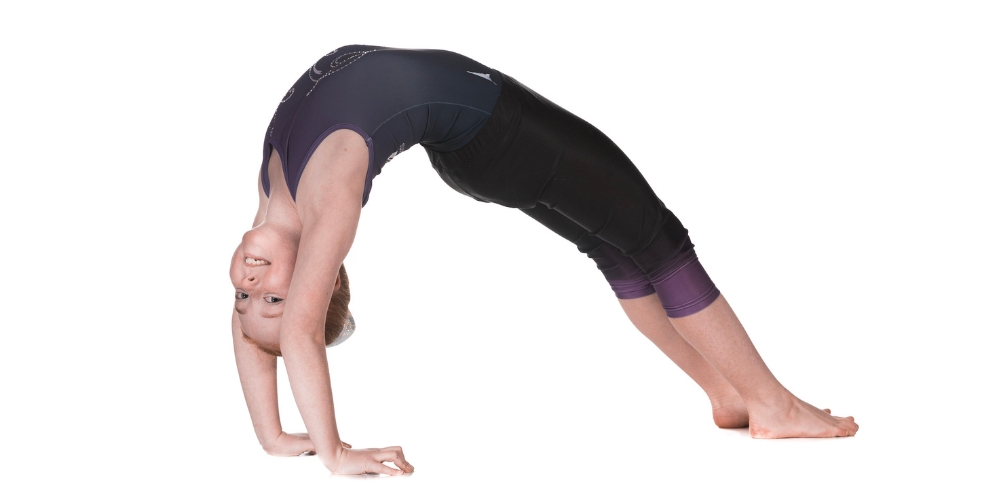
Bodyweight skills are physical movements or exercises that use an individual's body weight for resistance and performance, requiring strength, flexibility, balance, and coordination.
Here are the most common bodyweight skills to learn for those who are starting with gymnastics:
To begin, place your feet shoulder-width apart. Raise one arm aloft and kick the other leg sideways as you lower it. Kick the second leg over your torso while keeping your hands on the ground. Continue honing this movement while progressively picking up speed. Keep your composure and balance throughout the exercise.
Use a wall as support at first. With your hands shoulder-width apart, raise one leg and then progressively raise the other leg such that it leans against the wall. To find balance, practise shifting your weight with your hands. As you become more comfortable, try holding the handstand away from the wall while emphasising a straight body line and core engagement.
Place your hands on the ground as you begin in a squat. Roll forward, tuck your chin into your chest, and utilise your momentum to stand back up. First, practise on a softer surface to ensure a controlled and smooth roll. Work on keeping the roll tucked in and expanding it gradually for more fluidity.
Sit on the ground with your feet flat and knees bent to start. With your fingers pointing back, place your hands behind you. Tuck your chin into your chest as you raise your hips and roll back. To manage and support the roll, use your hands. Work on rolling from a standing position gradually, keeping your action smooth and controlled.
Lie flat on your back, your feet on the floor, and your knees bent. Place your hands next to your head with your fingers pointed towards your shoulders. Lift your hips and form an arch by applying pressure with your hands and feet. While maintaining a straight posture, use your core. As your flexibility increases, practise holding the bridge posture longer.
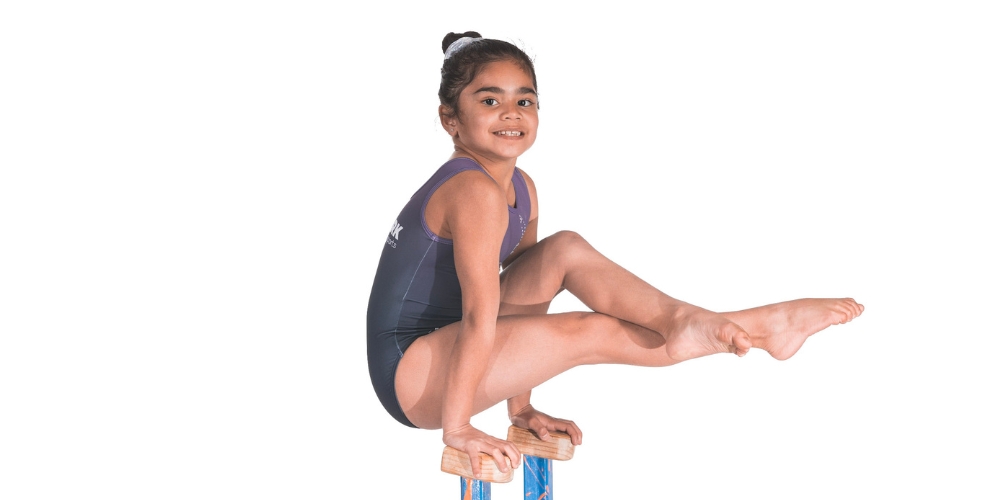
Vaulting skills involve using a springboard or vaulting table to perform acrobatic manoeuvres, showcasing a combination of strength, speed, and precision commonly associated with artistic gymnastics.
Start practising a handstand against a wall to strengthen your upper body. Next, concentrate on kicking one leg forward and generating a slight spring by pushing off with your hands. To achieve a controlled landing, gradually raise the spring's height and practise bringing both legs together. Throughout the exercise, emphasise good hand placement and core activation.
Start with a sturdy standing position. As you begin the roundoff, sweep one arm down and across your torso while kicking one leg up. Use the momentum to complete a fast cartwheel and land on both feet—practice in a straight line with a smooth and seamless transition. As you practise the roundoff technique, gradually improve your speed and precision.
The moonwalk is a dancing movement that gives the illusion of gliding backwards. Begin by standing one foot in front of the other. Shift your weight to the back foot and slide the front foot backwards without raising it off the ground. Repeat this motion with the opposite foot to get a continuous gliding effect. Concentrate on the sliding action and practise remaining balanced during the moonwalk.
Start in a standing position with your feet together. Step forward with one foot and extend both arms overhead. Place your hands on the ground and kick your back leg over, straightening it. Shift your weight to your hands and front foot, enabling the back leg to follow easily. Practice on a padded surface, focusing on fluid movements and maintaining a straight line.
Start in a standing position. Reach both arms aloft and lean backwards, hands on the ground. Kick one leg above your head while pushing with your hands and keeping a firm core. Allow the second leg to follow and finish the walkover. Start with a spotter, focusing on flexibility and control throughout the exercise.
Stand with your feet shoulder-width apart. Lift one leg forward, aiming at the highest point possible while remaining straight. Focus on activating the core for balance and control. Lower the leg back down and repeat on the opposite side. Begin with moderate and controlled motions, gradually increasing pace as you gain strength and flexibility.
Start standing with your feet shoulder-width apart. Lift one leg backwards, aiming for the highest height possible while remaining straight. Maintain equilibrium by engaging your core muscles. Lower the leg back down and repeat on the opposite side. Concentrate on controlled motions and gradually increase the height of the kick as you gain flexibility and strength.
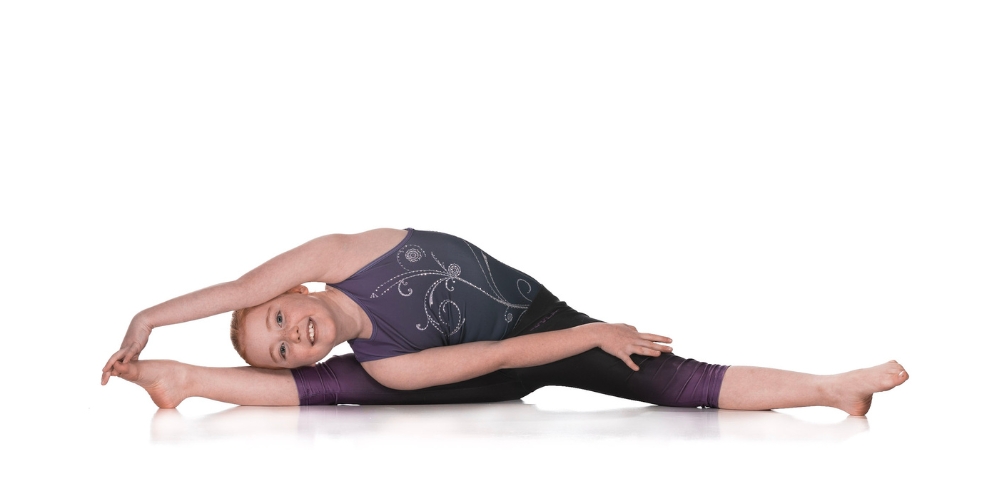
Create an environment in the gym that seems like a second home. Encourage everyone to maintain a cheerful and upbeat attitude, whether they are just starting or have been doing it for a while. Everyone may feel at ease and motivated when they see friendly faces, hear encouraging cheers, and are in a warm environment.
Consider gymnastics like learning to ride a bike. You want to master the fundamentals because they lay the groundwork for everything else. Spend time practising basic techniques and skills. It's like laying a solid foundation for a house; it makes the entire construction more stable.
Gymnastics is a personal journey. Find exercises and routines that align with your interests and preferences. Enjoy the process and make it your own. When you're doing something you enjoy, the overall experience improves.
Celebrate every achievement, no matter how big or tiny! If someone makes a new move or improves in any manner, show your appreciation by giving them a high five or a nice pat on the back. Positive feedback goes a long way towards increasing confidence and creating a supportive group.
Make your training sessions more interesting by incorporating amusing challenges. It might be a friendly competition, creating a fun obstacle course, or introducing skill-based games into your routine. These obstacles make studying and practising gymnastics more interesting and pleasurable.
Gymnastics is a team effort. Be a good sport and help your other gymnasts. If you see someone struggling with a relocation, offer some polite advice or aid. Creating a friendly community within the gym improves the overall experience for everyone.
Remember to have fun! Gymnastics is more than physical skill; it's about having fun along the way. Wear a smile, face the obstacles, and enjoy the successes. A cheerful mindset can make the gymnastics experience more rewarding and pleasurable.
Progress in gymnastics takes time. Set tiny, attainable goals, monitor your progress, and appreciate each achievement. Also, change up your routine to keep things new, and remember to appreciate the effort you're putting in.
Absolutely! Along with regular gymnastics training, incorporate dynamic stretching, yoga, and focused exercises for the shoulders, hips, and hamstrings. Incorporate these into your regimen to improve flexibility and avoid injuries.
Yes, you can! While professional coaching is ideal, there are plenty of bodyweight exercises, flexibility drills, and basic skills you can practice at home. Always prioritise safety and proper form.
While there's no strict dress code, it's advisable to wear form-fitting, flexible attire that allows for a wide range of movement. Avoid clothing with zippers or buttons to prevent injuries.
You may find many gymnastics training programs for beginners, and our list may look different. However, when it comes down to it, what's most important is that you enjoy what you're doing. Our list of tips might differ from what others suggest, but that's okay. The main thing is to find what feels right for you.
Different programs might have ways of doing things, but the main idea is to have fun and feel good about learning.
Whether doing flips on a beam or trying out the parallel bars, getting better at gymnastics is about having fun along the way. Keep trying new things, celebrating the small wins, and, most importantly, having a blast in every part of your gymnastics adventure.
And most importantly, choose the right gymnastic coach. Trust me, they are the key towards the achievement of your goals!
I know you're quick to notice that gymnasts seem lacking in height, and if you ask a regular person if they have an idea why, they will be quick to answer that - oh, it's because of the sport.
To tell you frankly, gymnastic training doesn't stunt your child's growth, just as everyone else believes in.
Hold on, let's unpack that giant whooshing sound of everyone jumping to conclusions!
I've been coaching gymnasts of all ages for more than twenty years, and let me tell you, height has nothing to do with talent. Think about it: wouldn't the greatest gymnasts be towering giants if that were the case?
So, let's drop the myths and dive into the real story about height and gymnastics. Buckle up because the truth might even surprise you!
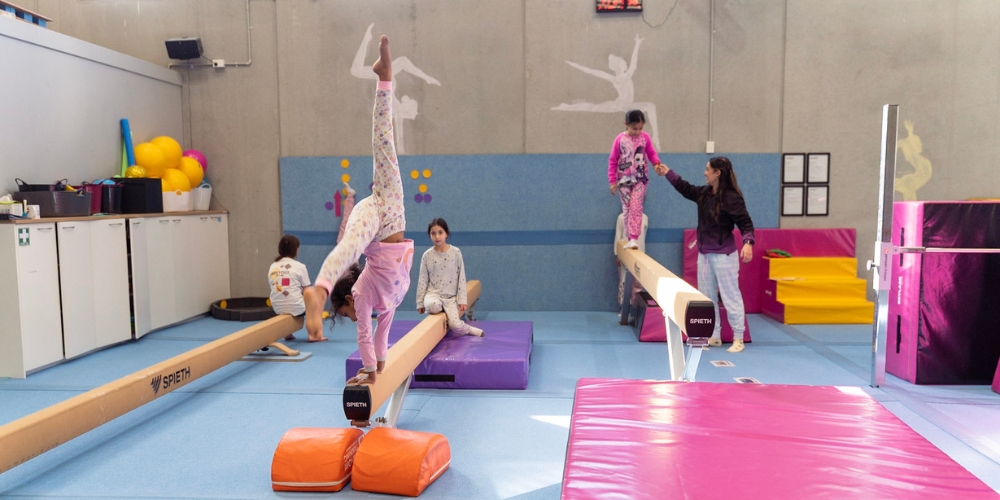
According to the Australian Bureau of Statistics (ABS), the average height for Australian men aged 18 and over is 178.6 cm (5 feet 10.5 inches). The average height for Australian women aged 18 and over is 166.2 cm (5 feet 5.4 inches).
The average height of a female gymnast is 4 feet 9 inches, while the average height of a male gymnast is 5 feet 4 inches. This is significantly shorter than the average height of the general population, which is 5 feet 4 inches for women and 5 feet 9 inches for men.
There are a few reasons why gymnasts tend to be shorter than average. One reason is that gymnastics is a weight-bearing sport, and shorter athletes have an advantage in this type of sport. This is because they have less weight, making it easier to perform acrobatic moves.
Another reason why gymnasts tend to be shorter is that they start training at a young age. When children start gymnastics at a young age, their bodies are still developing, and they are more likely to be shorter than their peers who do not start gymnastics until later in life.
According to a study published by the National Library of Medicine titled Role of Intensive Training in the Growth and Maturation of Artistic Gymnasts, despite ongoing debates about the impact of intensive training on the growth of young artistic gymnasts, a committee's literature review concluded that such training doesn't compromise adult height, affect body segment growth, or impact pubertal growth. While female gymnasts may be shorter for their age, this characteristic is likely a result of normal physical development rather than solely the consequence of training.
First, gymnastics will not stunt your child's growth when done right. It can be one of the most beneficial activities for their overall development. I've seen firsthand how gymnastics shapes strong, flexible bodies and builds resilient and confident individuals.
The idea that gymnastics restricts development is frequently based on outdated beliefs. Growth is mostly influenced by genetics and diet, not by the beautiful twists and turns on the balance beam. The idea that a child's height is harmed by gymnastic instruction is unsupported by scientific research.
Recognising that factors like genetics, hormones, and overall health play a more significant role in a child's growth than their involvement in gymnastics is crucial. As long as your child maintains a balanced lifestyle with proper nutrition, gymnastic training won't negatively impact their growth trajectory.
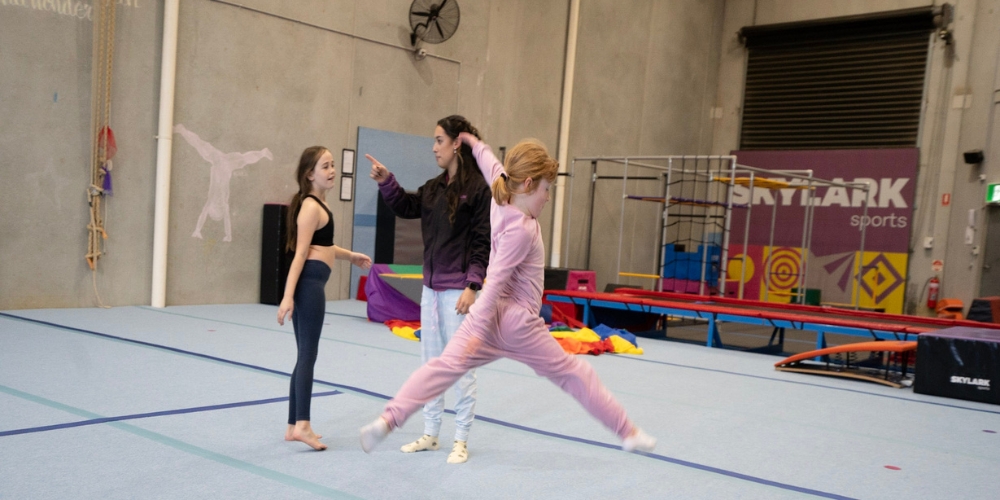
Let's now discuss the advantages. A wide variety of movements used in gymnastics support comprehensive growth. Gymnastic training is similar to a full-body workout that enhances your child's physical health by enhancing balance, coordination, and muscle strength.
Gymnastics is a great way to improve strength, flexibility, and cardiovascular fitness. These physical characteristics support your child's general health and lay a strong foundation for a healthy lifestyle.
Furthermore, gymnastics' demands for focus and discipline might benefit a child's emotional and cognitive growth. Your child will gain life skills beyond the gymnasium, such as goal-setting, time management, and tenacity.
Gymnastics teaches virtues like perseverance, collaboration, and dedication. As a coach, I've seen young gymnasts develop their physical skills and resilience, an important quality in many facets of life.
That being said, moderation is key. As a coach, I always stress the significance of leading a balanced lifestyle. Encouraging your child to engage in various activities can help them balance leisure, academics, and gymnastics. They must eat a healthy diet and get enough sleep to support their developing bodies.
Although gymnastics is an excellent way to grow, finding a balance is important. Overcommitting to one activity, in particular, can cause burnout and harm a child's general well-being. It is imperative that you, as a parent and coach, support diversity in your child's interests and endeavours.
There might be few rules, but ensuring your child eats a healthy, well-balanced diet that provides enough nutrients is still important. Speak with a nutritionist to customise food advice based on your child's exercise requirements and intensity.
Children may safely learn gymnastics skills when taught and supervised by certified coaches. Enrolling your child in a reputable gymnastics programme with knowledgeable instructors who put safety first is imperative.
It's crucial to heal and sleep well. Encourage your child to participate in relaxing activities, drink plenty of water, and get enough sleep.
Gymnastic training, far from hindering growth, can be a fantastic avenue for your child's physical, mental, and emotional well-being. So, if your little one dreams of somersaulting through the air or conquering the balance beam, let them spread their wings and fly – their growth won't be compromised, but their confidence and skills will soar to new heights.
Whenever we see balance beams, one thing comes to our mind - gymnastics! Sometimes, we would find our so-active kids somersaulting benches or performing gymnastic moves, acting like gymnasts.
Now, when we talk about an actual gymnastics balance beam, we're referring to a specific piece of equipment used in gymnastics routines. It's a narrow, rectangular beam elevated about four feet off the ground, and gymnasts perform a variety of skills and routines on it.
But what exactly is a balance beam, and why does it have such a grip on our budding gymnasts' imaginations? Let's break it down.
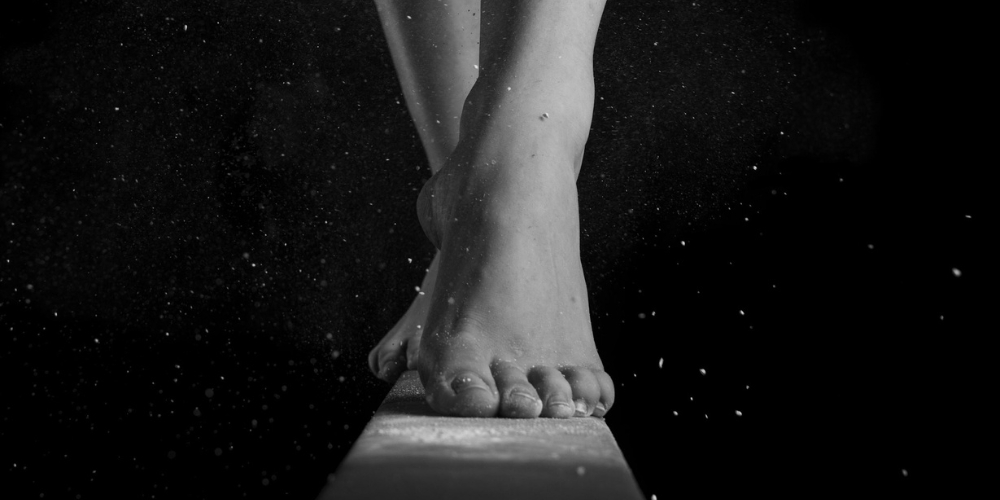
Balance beam is the gymnastic apparatus where we often see our gymnasts perform a variety of graceful and precise movements.
During our training, we often focused on developing the necessary skills and techniques to navigate and execute routines on the balance beam. The balance beam is a key component in artistic gymnastics, and training on this apparatus involves a combination of physical conditioning, technical skill development, and mental preparation.
The balance beam has been rocking the gymnastics scene for quite a while. Back in the day, it started as a wooden thing with little standardization. But, as gymnastics got more serious, they had to ensure everyone was playing on a level beam.
Fast forward to the '70s when Nadia Comăneci blew everyone's minds with that perfect ten on the balance beam at the Montreal Olympics – talk about setting the bar high! Over the years, gymnasts have been flipping, twirling, and pushing the envelope, making the balance beam routines a jaw-dropping spectacle. From the classic routines to the mind-boggling difficulty of today, the balance beam has seen it all, and it's still the heart of women's gymnastics.
Strength and simplicity come together in the creation of a balance beam. Balance beams are usually made of a mix of synthetic and wood elements. A non-slip material, such as suede or leather, covers the top surface where gymnasts perform, while the core, generally made of wood, provides stability. This material ensures that gymnasts demonstrate their skills on a stable yet grippy surface.
Britannica mentions that balance beams follow a standard length in gymnastics, measuring precisely 16 feet and 5 inches (5 meters) from end to end. This standardized length allows gymnasts to practice and perform routines consistently, whether in a training facility or a competition setting. The fixed length contributes to the uniformity and fairness of sports competitions.
Gymnastics routines and competitions revolve around the balance beam. It is a common piece of equipment in rhythmic and artistic gymnastics. On the balancing beam, gymnasts showcase their power, flexibility, and grace via complex routines. The balance beam takes centre stage, pushing gymnasts to demonstrate their talents in the most exacting and demanding way possible, whether in local gymnastics clubs, worldwide championships, or the Olympic stage.
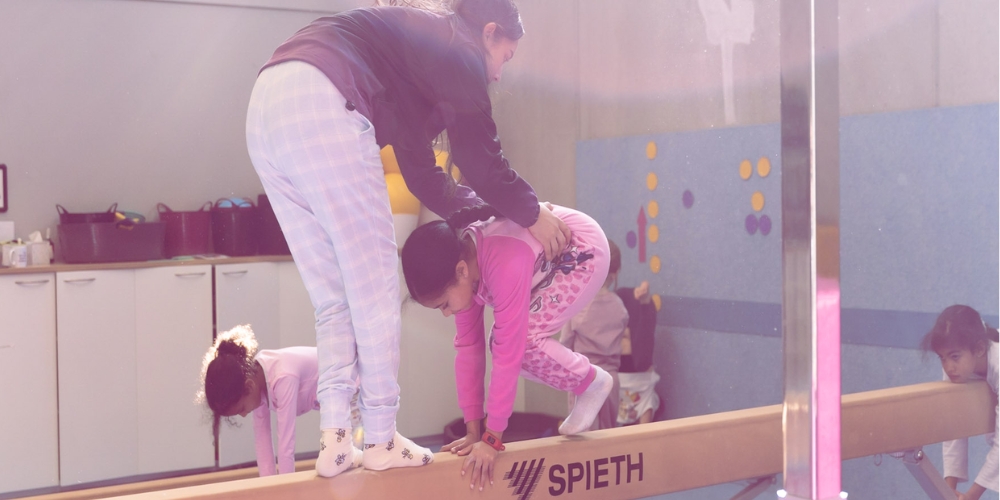
Gymnastics routines on the balance beam vary widely regarding difficulty, style, and choreography. However, certain elements and skills are commonly incorporated into routines at different skill levels. Here are some elements commonly seen in balance beam gymnastics routines:
Mounts are the ways gymnasts start their routines on the beam. This could involve various jumps, turns, or acrobatic elements.
Dismounts are the concluding elements where gymnasts dismount from the beam, often incorporating flips or twists.
Various types of jumps and leaps, including split jumps, straddle jumps, wolf jumps, and switch leaps.
Full turns, half turns, and other turning elements on one foot.
Gymnasts are often required to connect various skills seamlessly, demonstrating fluidity and control.
Incorporation of dance elements, such as turns, jumps, and expressive movements, to showcase artistry.
A combination of acrobatic elements performed consecutively, showcasing strength and precision.
Pivots and Turns on One Foot:
Various turns and spins are performed on one foot, showcasing balance and control.
Splits and other flexibility movements demonstrate the gymnast's range of motion.
Biles is a four-time Olympic gold medalist and 19-time world champion. She is known for her incredible difficulty and consistency on the balance beam.
Raisman is a two-time Olympic gold medalist and six-time world champion. She is known for her elegant and graceful style on the balance beam.
Ponor is a three-time Olympic gold medalist and four-time world champion. She is known for her powerful and dynamic routines on the balance beam.
Cheng is a two-time Olympic gold medalist and four-time world champion. She is known for her high-flying acrobatics and difficult dismounts on the balance beam.
Johnson is a two-time Olympic gold medalist and four-time world champion. She is known for her consistency and execution on the balance beam.
And speaking of awards and achievements, you might want to check out an article we published where we shared our proud moments so far through these years! Please see it here!
The beam can aid in developing mental and physical abilities like perseverance, discipline, and attention, as well as physical abilities like strength, flexibility, and agility. To begin, beginners can start with basic activities like walking or sitting on the beam and work up to more difficult manoeuvres like jumps and turns.
The balance beam is suitable for various ages, with kids as young as 5 or 6 often starting in recreational gymnastics classes. It's adaptable, allowing young gymnasts to build confidence on lower beams before progressing to standard heights as they grow and develop their skills.
Men have their apparatuses in artistic gymnastics, and the balance beam is exclusive to women's gymnastics. Men typically focus on events like floor exercise, parallel bars, rings, vault, pommel horse, and high bar, each requiring unique skills and strengths.
So there you have it! Balance beams may look as normal as any other gymnastic equipment. But these platforms are among the most used apparatuses among successful and well-known gymnasts, turning a seemingly simple beam into a stage for extraordinary performances.
Now that you finally realise that you or your kid is into gymnastics, how do you start?
Well, of course. Let's start with the basics! It would help if you prepared a few things for the exciting journey ahead in gymnastics. So, what essentials will set you on a fantastic start?
Let's find out!
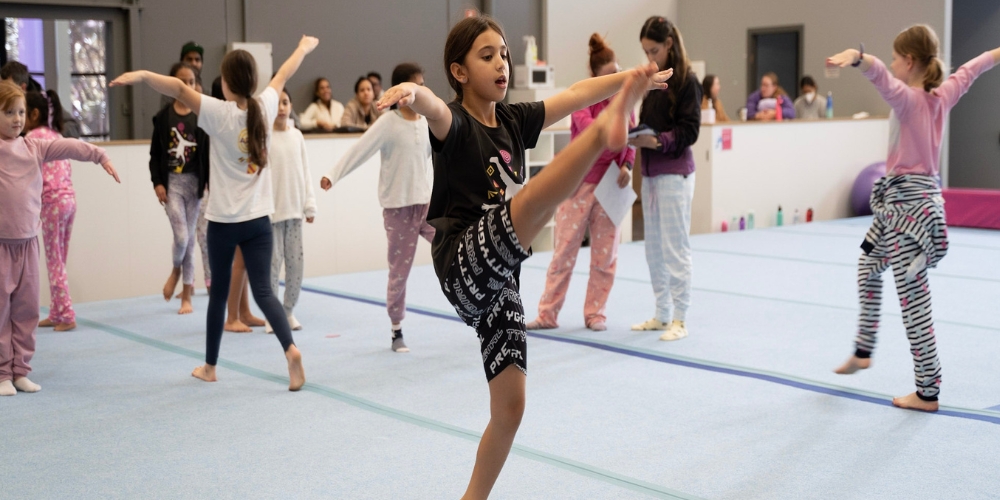
The most important piece of equipment for any gymnast is a gymnastics mat. Stretches, floor routines, and tumbling passes may be performed safely and supportively on this padded surface. By acting as a barrier, the mat lessens the force on joints and lowers the possibility of injury during landings. Ensure the gymnastics mat you choose fits your training programme's unique requirements by considering thickness, durability, and size. A premium mat is a must to create a safe and cosy space that promotes skill development and injury prevention.
The leotard is more than a costume; it represents the focus and discipline essential to gymnastics. With its one-piece design, this outfit maximises the range of motion, making it easier to perform complicated routines with elegance and grace. In addition to improving a gymnast's flexibility, a well-fitting leotard adds to the sport's visual attractiveness. In addition to its practical advantages, donning a leotard during practice and competitions instils a mindset of dedication and commitment to the artistic quality of gymnastics.
Gymnasts performing bar exercises need gymnastics grips for hand protection. These grips, usually made of leather, improve bar traction and protect against calluses and blisters. Selecting the appropriate grips is essential because they allow gymnasts to confidently and controllably execute complex routines on uneven, parallel, and high bars. Gymnastics grips are essential for improving technical proficiency on a variety of apparatuses and for enhancing safety during training.
In gymnastics, chalk is an essential item for keeping a firm hold. Chalk is a moisture-absorbing substance applied to the hands and occasionally other body parts. It ensures a dry surface and lowers the risk of slipping when performing exercises on bars, rings, and other equipment. Beyond its usefulness, the gymnastics ritual of chalking up symbolises focus and preparedness and is deeply embedded in the culture. A gymnast with sufficient chalking can perform complex movements, swings, and dismounts with assurance and accuracy.
See our blog about "What do gymnasts put on their hands?" to learn more about chalk.
Staying hydrated is crucial in gymnastics, where physical effort is high and ongoing. A water bottle is an essential training session since it offers a convenient and quick way to stay hydrated. Regular water consumption promotes overall performance, helps sustain energy levels, and facilitates healing. Selecting a water bottle that is both spill-proof and conveniently located guarantees that staying hydrated becomes an integrated aspect of the gymnastics routine, enhancing endurance and overall health.
Resistance bands are versatile tools that give gymnastics training additional complexity. Because they offer varying resistance, these elastic bands are perfect for focused muscle engagement, flexibility exercises, and strength training. Resistance band training increases muscular tone, general strength, and body control. Resistance bands provide a dynamic and efficient approach to supplement traditional gymnastics training, from warm-up drills to specific sessions, helping to develop a resilient and well-rounded athlete.
A video recording gadget, such as a camera or smartphone, is a great tool for gymnasts who want to improve. Athletes can identify areas for improvement and refinement in their form, technique, and performance by reviewing their recorded practice sessions. Self-evaluation is made possible by the playback feature, which also offers insights that might not be seen during the real routine. This tool takes on the role of a coach's eye, supporting the growth of muscle memory, skill improvement, and the pursuit of gymnastics perfection. Frequent video analysis becomes essential to training, encouraging a proactive attitude towards skill development and ongoing self-improvement.
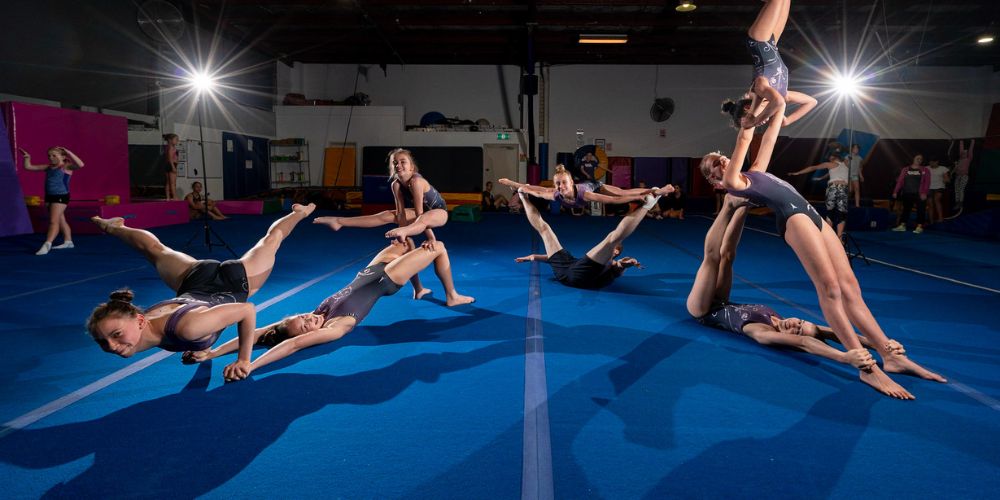
Taking up gymnastics is a fascinating endeavour that blends discipline, artistry, and athleticism. Enough preparation is essential for a successful start, whether you're a newbie excited to explore the world of flips and tumbles or someone returning to gymnastics after a break. These seven-pointers will help you feel more prepared and confident as you enter the exciting and dynamic gymnastics world.
The first thing you should do while starting gymnastics is to locate the ideal facility. Investigate nearby gymnasiums, read reviews, and consider elements like the calibre of the coaching staff and the equipment. You can assess the atmosphere and choose where to start your gymnastics journey by visiting the facility in advance.
Learning the basic terms and ideas of gymnastics will help you feel more at ease when you begin to train. You can follow directions and participate completely in your training sessions if you are familiar with the fundamentals of each apparatus and common exercises.
The appropriate clothes directly impact your performance and are not just for show. Purchasing a leotard that fits properly guarantees comfort and range of motion. It will assist to be aware of the gym's attire policy and any equipment needs so that you can show up ready for every session.
Certain gymnasiums may require personal equipment, such as grips or certain shoes. Ensuring you have everything you need for a smooth and pleasurable training session is best achieved by checking in with your coach or the gym administration.
Prioritising strength and flexibility training is wise before beginning official gymnastics training. Strengthening and stretching activities can help your body better prepare for the demands of gymnastics. Please include them in your workout plan.
Learning the fundamentals of gymnastics at home prepares you for a more seamless transition to formal instruction. Simple movements like handstands and forward rolls can be practised to help develop confidence and familiarity with the fundamentals of the sport.
Starting with introductory gymnastics courses is a disciplined and encouraging way to start. These courses are meant to gently educate beginners about the sport while emphasising the fundamental abilities and methods. Starting with these classes will guarantee that you have a firm grasp of the foundations and that your gymnastics journey gets off to a good start.
Since not all classes include warm-ups, the teacher might assume that your child has warmed up in advance. The best preparation you or your child can do if you arrive early is to stretch as you wait for the lesson. Their body will be ready for whatever the day has in store for them in this way.
Absolutely! Many gymnastics programs cater specifically to adults. Classes are designed to accommodate various skill levels and age groups, whether you're a complete beginner or returning to the sport.
No, gymnastics is for everyone, not just those interested in competition. Many people participate in gymnastics for fitness, fun, and skill development. Whether you have aspirations of competing or want to enjoy the physical and mental benefits, there's a place for you in gymnastics.
The frequency of practice depends on individual goals, schedules, and fitness levels. Starting with one to two classes per week is common for beginners. Consistency is more important than frequency; gradual progression prevents injuries.
Entering the world of gymnastics is a thrilling adventure full of opportunities. From knowing the necessary equipment to mastering the fundamental motions, you're ready for an experience that blends power, elegance, and fun. Therefore, enjoy the learning process and recognise and appreciate every accomplishment, no matter how tiny, whether you're flipping bars or honing your balance on the beam.
Now, it's your turn! Take that leap, sign up for a class, and let the mats be your playground. Remember, the journey is just as exciting as the destination, and every twist, turn, and tumble brings you one step closer to mastering the art of gymnastics. So, what are you waiting for? Grab your leotard, chalk up those hands, and let the gymnastics adventure begin! See you on the mat!
From an audience point of view, gymnastic floors look like a springy stage where all the magic happens, right? But let me tell you, there's more to that floor than meets the eye!
You've seen us doing cartwheels, backflips, and sticking those landings like pros. But have you ever wondered what makes our gymnastic floor so special? What makes this simple space the perfect playground for our flips and tumbles?
The gymnastics floor, spring or tumbling floor, is a specialized surface used in gymnastics competitions and training. It provides a safe and supportive base for gymnasts to perform their routines, ensuring comfort and safety during high-impact landings and tumbling passes.

Amidst the glamour and breathtaking gymnastics moves and tumbles our gymnasts make, their safety is always a top priority. As instructors, we understand that every flip and landing involves a calculated risk, and that's where the gymnastic floor steps in as a silent guardian.
Imagine not having a responsive, soft bottom while landing after a spectacular mid-air flip. Ouch! That's why the shock-absorbing capabilities of the gymnastic floor are so important. Specialised foam and technology work together like a cushion to protect our gymnasts' joints by absorbing impact. It functions similarly to a safety net, guaranteeing each landing is as thrilling as safe.
It's the landings that make up a flawless routine, not just the flips. The gymnastic floor ensures that each landing is controlled and exact. Our gymnasts can confidently land those landings because of its special materials, which offer the ideal grip. This accuracy reduces the possibility of slips and falls and serves a safety purpose.
It is possible to worry about injuries in the erratic world of gymnastics. The robust nature of the gymnasium floor serves as a safety barrier. Together, the springs and foam provide a sensitive surface that lessens the force applied to the bodies of our gymnasts. It's similar to having a dependable partner who supports them when they recover from difficult maneuvers and ensures they can continue pushing the boundaries without endangering their safety.
Our gymnasts feel more confident knowing they have a sturdy and secure surface underneath them. They can concentrate on their routines without worrying about the surface they are performing on. Not only does this confidence provide them with a psychological lift, but it also makes their performance safer overall.
The gymnasium floor is a driving force behind advancement, creativity, and safety. It gives our gymnasts a stage to experiment with new movements, challenge their limits, and develop their routines. They are encouraged to try new things on a safe and encouraging floor, which helps gymnastics as a sport continue to develop.
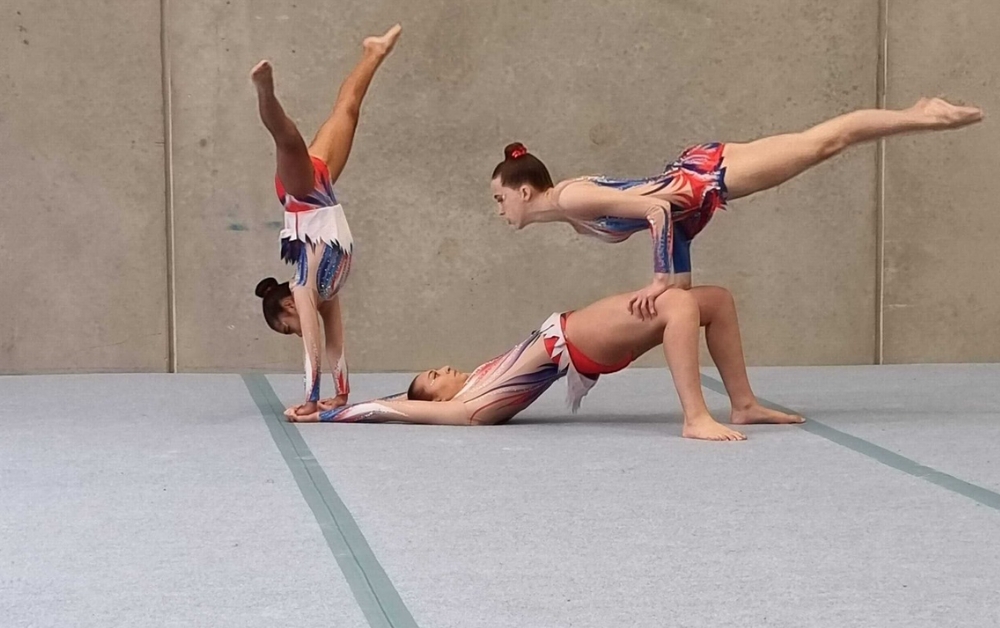
Have you ever marveled at the seamless flips and tumbles on the gymnastic floor? It's not just the athletes' skill; the carefully crafted combination of materials makes those feats possible. Let's take a peek behind the scenes and uncover what goes into gymnastic floors:
At the core of every gymnastic floor lies foam. Specially designed foam layers provide the necessary cushioning and shock absorption. This ensures a soft landing for our gymnasts, minimizing the impact on their joints and allowing for a safer and more comfortable performance.
Have you ever wondered how gymnasts pull off those amazing rebounds? The secret sauce is the springs that are buried beneath the surface. These springs add to the floor's elasticity, making it responsive and allowing gymnasts to land gracefully. It excites each routine, like having a trampoline underneath the mat.
A gymnasium floor's top layer is frequently covered in vinyl or carpet. This covering has two functions: it gives the athletes traction to make exact motions and gives the floor a decorative touch. The choice of covering affects the usefulness and appearance of the floor and is influenced by elements such as grip, durability, and overall feel.
Beneath the foam and springs, a wood subfloor usually acts as the structural foundation. This sturdy layer provides stability and support to the entire gymnastic floor system. The quality and type of wood used can impact the overall performance and longevity of the floor.
Have you ever wondered how the mats hold their place during those routines that defy gravity? The mats are frequently fastened to the floor with velcro strips to ensure they remain in place and don't move during energetic performances. A minor element makes a big difference in keeping our gymnasts' surfaces safe and steady.
A metal frame is often incorporated into the design to give the floor its shape and structure. This frame provides rigidity and defines the boundaries of the floor. It's like the invisible scaffold that supports the entire performance area, ensuring a defined and secure space for gymnasts to showcase their skills.
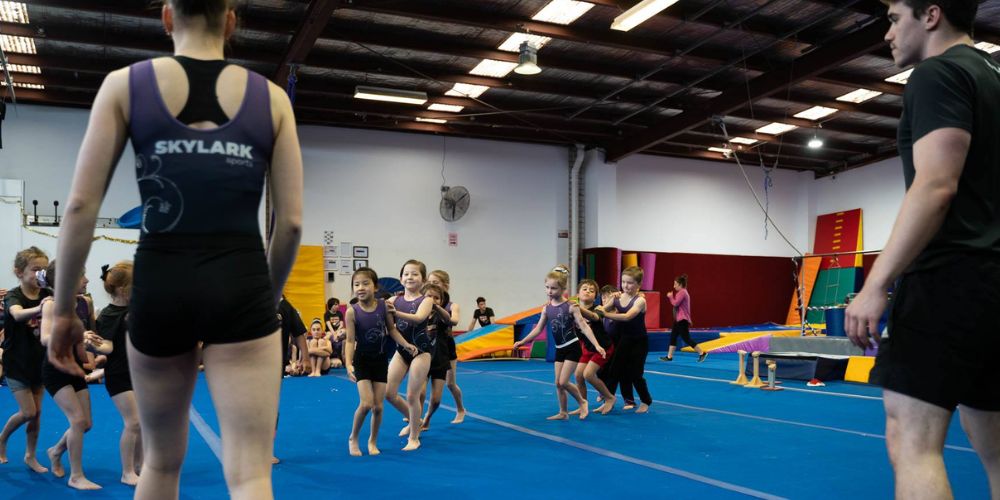
Accidents happen when you least expect them. That's why, in our facility, we never take things for granted regarding our gymnasts' safety. Here's how we ensure that our gymnastics floor is always safe to use:
Visual checks regularly are a must. At our facility, we meticulously examine the entire gymnastics floor, looking for any signs of wear, tears, or damage. We ensure every inch of the mat is in excellent shape, leaving no space unturned.
We believe in the Goldilocks principle: the floor should be just right. Now and again, our coaches go across the floor to make sure the stiffness remains constant. Anyplace that feels unusually soft or hard indicates that there may be a problem with the foam or springs, which needs to be looked at and fixed.
In gymnastics, a little bounce goes a long way, but it needs to be precisely right. To determine how efficiently the floor absorbs shock, we conduct a bounce test in which we leap from a moderate height. It should offer a soft landing devoid of undue bounce or startling collision. We investigate if something seems wrong.
Athletes should feel in control, not slipping and sliding. Our instructors often stroll and execute deliberate moves to gauge the grip and traction of the floor. Whether the flooring is vinyl or carpet, we ensure enough friction stops people from slipping and falling.
If several mats on the gymnasium floor are fastened together with Velcro strips, examine the fastening system. The mats should be firmly fixed, and the Velcro strips should be in good shape. Unsecured matting can cause trip hazards and disturb the level of the flooring.
Examine the metal frame that delineates the gymnasium floor's perimeter. Ensure there is no obvious damage or instability and it is firmly in place. A sturdy frame reduces potential risks around the edges and adds to the floor's overall stability.
Sometimes, you need an expert eye. That's why we bring in professionals for a thorough inspection. Their trained expertise helps identify subtle issues that might go unnoticed during routine checks. We value the added layer of assurance they provide.
Our athletes are our partners in safety. We encourage them to communicate discomfort, unusual sensations, or concerns during practice or performances. Their feedback is invaluable in catching potential safety issues early on.
The fastening mechanism of our mats is regularly inspected to ensure they are securely attached with Velcro strips. Loose mats are not only a tripping hazard but can also disrupt the evenness of the floor surface.
Signs such as uneven areas, tears in the covering, or visible damage to the subfloor are red flags during inspections. These indicators prompt us to investigate further and promptly address potential safety issues.
Regular inspections include assessing the wood subfloor's stability and the gymnastic floor's structural foundation. Any issues identified are addressed promptly to ensure the overall stability and safety of the floor.
So, if you think the gymnastics floor is just a surface for flips and tricks, think again. It's not just a stage; it's the heartbeat of our gymnastic world, ensuring every routine is a safe and spectacular performance.
From routine inspections to bounce tests, we leave no stone unturned to guarantee that our gymnastic floor is more than a floor—it's a reliable partner in every landing, every jump, and every routine.
So, the next time you watch a gymnastics performance, remember that beneath every twist and turn lies the assurance of a floor meticulously designed for safety and success. It's not just a floor; it's the foundation for every soaring moment in gymnastics.
As parents, witnessing our toddlers' boundless energy and enthusiasm is a daily adventure. Harnessing and channeling that exuberance into a constructive and engaging activity can be exciting and beneficial.
If you've noticed your little one flipping, jumping, and tumbling around the living room, consider introducing them to the captivating world of gymnastics. However, preparing toddlers for gymnastics involves more than just signing them up for a class.
So, you're thinking about introducing your little one to the world of toddler gymnastics? Great call! I'm here to explain why gymnastics for toddlers is more than just adorable tumbles and mini-saults.
Toddlers are developing their motor skills at a critical juncture. Toddlers who participate in gymnastics can improve their gross and fine motor abilities, strengthen their bodies, and perfect their motions.
Many balancing exercises are part of gymnastics practices, greatly improving a toddler's coordination. Learning to regulate motions while maintaining balance on various apparatuses lays the foundation for better coordination and spatial awareness.
Gymnastics exposes young children to a supervised setting to socialise with other children. Together with developing social skills, cooperation, and teamwork, group exercises and activities help the young gymnasts develop a sense of togetherness.
A toddler's confidence can greatly increase through gymnastics as they learn new abilities and overcome obstacles. Gradual improvement in gymnastics builds a sense of accomplishment that benefits one's self-image in other spheres of life.
Gymnastics requires comprehending bodily positions, memorising routines, and obeying directions—all beneficial to cognitive growth. Toddlers who participate in gymnastics frequently show increased focus and processing speed.
Gymnastics programmes offer a regulated setting where young children can learn the values of self-control and obedience. Early establishment of these bases can positively impact a child's attitude towards learning and adjusting to norms in different contexts.
Gymnastics gives toddlers, who naturally have a lot of energy, a fun and interesting way to get it out. Frequent gymnastics practice improves cardiovascular health, strength, flexibility, and general physical fitness.
Gymnastics lays the foundation for many sports and physical activities. Strength, flexibility, and body awareness are among the abilities and talents that gymnasts develop, and these can be useful when switching to other sports later in life.
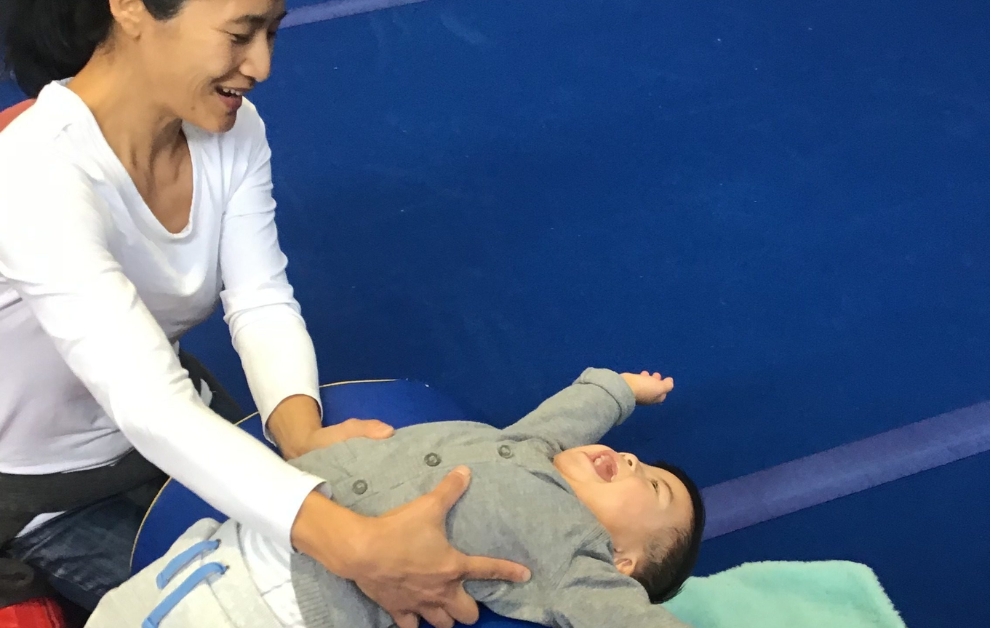
Although toddlers are explorers by nature, watch out for those who go above and beyond. Your child's interest in movement could be a wonderful fit for gymnastics if they are always moving, exploring their physical boundaries, crawling through tunnels, and climbing furniture.
Toddlers are like little energy bundles, as we all know. Suppose they've turned your living room into their obstacle course and are bouncing off the walls. In that case, that unbounded energy is a strong sign that they possess the vitality required for gymnastics, which is dynamic and active.
In terms of absorbing knowledge from their surroundings, toddlers are like sponges. Your child is probably naturally inclined to engage in physical activities, which makes them a fantastic fit for the world of gymnastics. You may notice them doing small somersaults, mimicking dance motions, or even duplicating stretches they've seen elsewhere.
Does mentioning "gymnastics" make your toddler's face light up with excitement? Do they enquire or try pronouncing the term with cutesy enthusiasm? An enthusiastic reaction to the concept of gymnastics suggests a sincere curiosity, which can greatly enhance the learning experience.
As they age, toddlers often use different methods to show their independence. Your child is ready for the hands-on, self-driven activities that gymnastics promotes if they insist on performing tasks themselves, such as putting on their shoes, trying to feed themselves, or zipping up their jacket.
Even while each child develops at their rate, age may generally be used to predict a child's preparedness for a given activity. Around age two or three, most gymnastics programs begin to accept toddlers. If your child falls into this age range and shows indications of being physically ready, gymnastics is a worthwhile alternative to explore.
Is your little one spading their social wings? Gymnastics classes can provide a structured and playful environment for social interaction if they're becoming more comfortable around other children, engaging in parallel play, or showing excitement about playdates. It's not just about flips and tumbles; it's an opportunity to make new friends and learn in a group setting.
I will always remember the excitement of every little one's first gymnastics class at our facilities like yesterday. It's a moment filled with anticipation, giggles, and the palpable energy of tiny adventurers ready to take on the gymnastics world. Preparing for this special occasion involves a blend of practicality and a sprinkle of magic. Here's a guide to ensure that your first gymnastics experience is not just memorable but utterly delightful.
Here are six tips to make that first experience a total win:
We're about to embark on this gymnastics journey. The key here is comfy attire. I'm talking stretchy pants, a snug shirt, and maybe even a cute leotard if your toddler feels fancy. Oh, and don't forget those non-slip socks or teeny-tiny gymnastics shoes—essential for grip and style.
is anyone up for a pre-game pep talk? Make gymnastics sound like the trip of a lifetime to excite your toddler: huge smiles, high fives, and an outline of all the awesome actions in store for them. Creating an exciting environment sets the stage for eager expectations instead of pre-class anxieties.
Come a little early so your child may enjoy the ambience of the gym. Discover the vibrant mats, say hello to other small gymnasts and, of course, make sure everyone is prepared for action with a quick trip to the loo.
Consider the warm-up to be a little stretch-a-thon or a pre-class dancing party. Preparing physically is only one aspect of it; another is making the beginning of the session an exciting occasion. A bit of warm-up playfulness goes a long way.
Take a backseat, but make it a cheerleading one. Find a comfy spot to observe, give your toddler room to shine independently, and hit them with a big smile and a thumbs up whenever they glance your way. Positive vibes only!
In the realm of toddler gymnastics, any small accomplishment is a victory. Whether it's a stable balance posture or an effective roll, ensure the victory dance is ready after class. Celebrating those victories with sincere delight increases their confidence for the following round and feeds their love of learning.
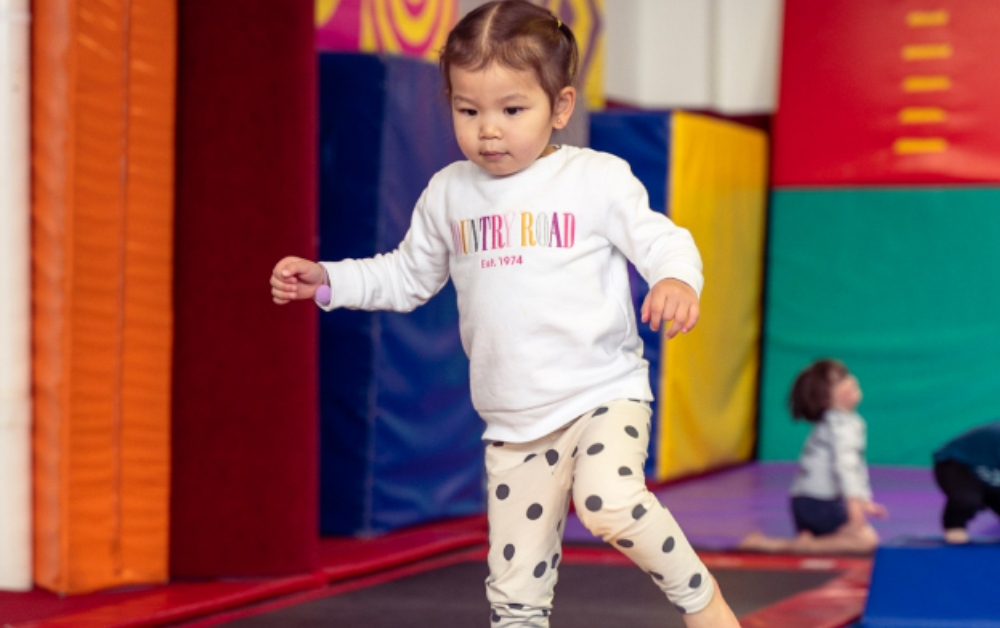
Choosing the right gymnastics program for your little one is like finding the perfect balance beam—it requires a bit of exploration and a keen eye for what suits your child best. Here's a guide to help you navigate the exciting world of gymnastics programs and find the perfect fit:
First things first—pick a class that's like a customised playdate for your toddler. Age-appropriate programs are like finding the right puzzle piece; they fit snugly with your little one's developmental stage and keep the fun vibes flowing.
Picture your gymnastics coach as the ringmaster of a circus, but with more leotards and less lion-taming. You want someone who knows their cartwheels from their handstands and speaks toddlerly fluently. Patience and enthusiasm should be their middle names. A coach who can turn every lesson into a little adventure? Gold.
Safety is our superhero; a clean, well-maintained gym is its secret lair. Look for a place where the floors are padded, the equipment is tip-top, and safety measures are top-notch. We're in the business of creating happy memories, not ouchies.
Toddlers are like tiny tornadoes of energy. That's why a good gymnastics program should feel like a mix of playtime and skill-building. Think games, imaginative activities, and exercises that engage those little minds and bodies. Are they learning through play? That's our jam.
Before you commit to the long haul, dip your toes in with trial classes. It's like a sneak peek into the gymnastics wonderland. Watch how your kiddo reacts, see if they're having a blast, and gauge if the program aligns with your expectations. Oh, and don't forget to pop your head in during a regular class—it's like window shopping but for gymnastics classes.
Try to keep things lighthearted and upbeat on the first day. Tell them it's all about having fun, share your excitement, and give them support. A simple pre-class routine or a preferred snack can reduce anxiety.
Choose a healthy, light snack approximately half an hour before class. A little sandwich, yoghurt, or banana can give you the energy boost you need for the activities.
Although unnecessary, non-slip socks or shoes made specifically for gymnastics can offer superior traction and grip. See if the programme has any special suggestions by contacting them.
Tantrums are par for the toddler course! Maintain a positive attitude, acknowledge their feelings, and try to find a compromise. Establishing a routine and incorporating a favourite element into the pre or post-class ritual can also help.
And just like that, your little one is ready to start their gymnastics journey! From selecting the ideal programme to getting ready for that thrilling first class, the trip is full of laughs, stumbles, and little victories. As a gymnastics coach, I would tell you to savour every precious moment, recognise your little one's accomplishments, and get giddy when they start to realise how amazing movement is.
Remember that it's about more than flips and turns—it's about developing self-assurance, encouraging a love of exercise, and making priceless memories. Prepare yourself for a voyage filled with tonnes of laughing, a dash of curiosity, and a lot of toddler magic as you embark on your gymnastics journey.
For regular eyes, gymnastic routines and apparatus all look the same. We are often left in awe of how amazing and graceful every gymnast would execute their moves on the gymnastic floor or bars.
But do you know that the bars used in gymnastics are different? There are the parallel bars, and then there are the enchanting and challenging uneven bars, which add a unique dimension to the world of gymnastics.
What are uneven bars, then, and how do they differ from other bars?
At Skylark Sports, the uneven bars are a dynamic apparatus where our athletes showcase impressive skills and maneuvers. The routine typically begins with a mount, where the gymnast gracefully positions themselves on one of the bars before initiating a sequence of movements.
Let's explore the uneven bars further in this blog.
So, uneven bars are horizontal bars set at different heights. These bars aren't just random pieces of gym equipment. They're like the stage for a gymnastics performance, adding a unique twist to the routines. It's the apparatus where gymnasts show off their gravity-defying moves and make us regular folks stare in amazement.
But here's the kicker – mastering these uneven bars takes a combo of strength, finesse, and a touch of artistic flair. As a gymnastics enthusiast and trainer, I've seen firsthand how athletes use these bars to create a dance in mid-air. It's not just about swinging around; it's a routine filled with twists, flips, and jaw-dropping releases.
Since gymnastics is a collaboration of creative minds working together to improve the sport, the use of uneven bars started in 1930, according to an article published about uneven bars in Britannica.
Gymnastics underwent much change as coaches and athletes sought new methods to display athleticism and talent. Gymnasts could experiment with dynamic moves and produce captivating routines thanks to the advent of uneven bars. Even though the precise source of the uneven bars' development is unknown, gymnasts, coaches, and equipment designers worked together to create the apparatus we use today in the 1930s.
Uneven bars in gymnastics are typically made with fibreglass or composite material for the bars themselves, and the frame is constructed using steel.
Gymnasts can execute complex routines without feeling burdened by bulky equipment thanks to fiberglass's reputation for being both lightweight and strong. The composite material, which is frequently a blend of several elements, is precisely designed to offer the ideal level of flexibility without sacrificing structural integrity. Gymnasts need this flexibility to swing, release, and grasp during their routines.
Usually made of steel, the frame provides stability and support for the entire apparatus. Steel is the perfect material to withstand the dynamic forces gymnasts apply during routines because of its extraordinary strength and durability. The uneven bars' steel frame is their structural support, giving gymnasts the confidence they need to execute.
The uneven bars are two horizontal bars arranged at various heights to provide an asymmetrical and visually arresting arrangement. Imagine that one bar is positioned lower, perhaps 170 centimetres above the floor, calling on gymnasts to begin their routines. Its opposite, the upper bar, floats slightly above 250 centimetres, giving the device a sense of grace and challenge.
In terms of appearance, the bars form a dynamic, open-ended structure when they appear parallel. The lower bar, closer to the audience's eye level, provides an inviting starting point for gymnasts to showcase their skills. As the eyes move upward, the higher bar adds a touch of drama and anticipation, daring gymnasts to elevate their routines to new heights.
The uneven bars routine basically includes skills such as swings, handstands, releases, and dismounts.
The exercise on this apparatus involves continuous swinging movements in both directions, incorporating grip changes, releases, catches, and circle swings through the handstand position, with elements of twists and somersaults for maximum scoring while incurring penalties for falling or hitting the mat with feet.
At our gymnastic facility, each uneven bars routine is a unique blend of strength, agility, and personal style.
Here are the usual routines our gymnasts execute during training with uneven bars:
The routine begins with a mount, where our gymnasts elegantly position themselves on one of the bars to initiate the performance.
Dynamic swings between the high and low bars are a fundamental component. Our performers generate momentum through swings, displaying controlled movements and setting the rhythm for the routine.
Gymnasts seamlessly transition between the high and low bars, incorporating a variety of moves such as straddles, pikes, or clear hips. These transitions add complexity and visual appeal to the routine.
Daring release moves involve letting go of one bar, performing twists, flips, or somersaults, and then grasping the bar. These elements demonstrate the gymnast's courage, aerial skills, and confidence in executing challenging maneuvers.
Handstands on the bars and pirouettes contribute to the artistic aspect of the routine. Gymnasts display strength, balance, and precision as they move through inverted positions.
Circles and swings in different directions showcase the gymnast's control and fluidity. These elements, performed gracefully and precisely, add an aesthetic quality to the routine.
The routine concludes with a dismount, the grand finale. Gymnasts perform twists and somersaults before sticking the landing on the mat. A successful dismount is crucial for a strong finish to the routine.
Although uneven bars are a common tool in gymnastics competitions, they have different applications in gymnastics facilities. Beginners usually begin with fundamental techniques and work their way up to more complex ones under the supervision of trained coaches.
Yes, uneven bar routines in competitions are subject to particular regulations and restrictions set by the bodies that oversee gymnastics. These standards cover routine composition, difficulty, execution, and dismount criteria.
Judges score uneven bar routines according to several criteria, such as difficulty, artistic merit, execution, and composition. Errors or a lack of precision in the routine may be deducted.
Yes, gymnastics competitions frequently divide routines into multiple skill levels depending on how complex the elements are executed. More complex and difficult manoeuvres are needed at higher skill levels.
Alright, if you're thinking uneven bars are just metal things for gymnasts to swing on, you're missing the whole picture. They're not just cold gym stuff; think of them as magical stages where we gymnasts bring out our strength, grace, and artistic style.
Being a coach at Skylark Sports, I've seen how these uneven bars are more than just gym tools. They're like super boosters for personal growth, pushing gymnasts to do cool stuff in the air, beat tough challenges, and tell stories with their moves. It's not just about swinging on bars; it's about gymnasts becoming superheroes, defying gravity and turning every routine into their adventure. Uneven bars are like the special ingredient that makes gymnastics at Skylark Sports way more than just exercise – it's a journey up in the air!
What do gymnasts put on their hands? Well, the answer is quite simple: magnesium carbonate, or chalk as we fondly refer to it in the world of gymnastics. But let me take you on a journey to understand this seemingly ordinary substance a bit better...
As the owner of a gymnastics club, one of my least favourite things to hear during a training session is, "We're out of chalk." To be clear, we're never actually out of chalk. We keep it stashed in three different places just in case our inventory system fails us. But if, for some reason, we have to dip into the hidden stash, you can bet that the very next morning, I'll be heading to Amco Gymnastics for a bulk purchase (should I link this site? They are a close supplier we use). Chalk is as ubiquitous in gymnastics clubs as leotards and balance beams, and my club, Skylark Sports, is no exception.
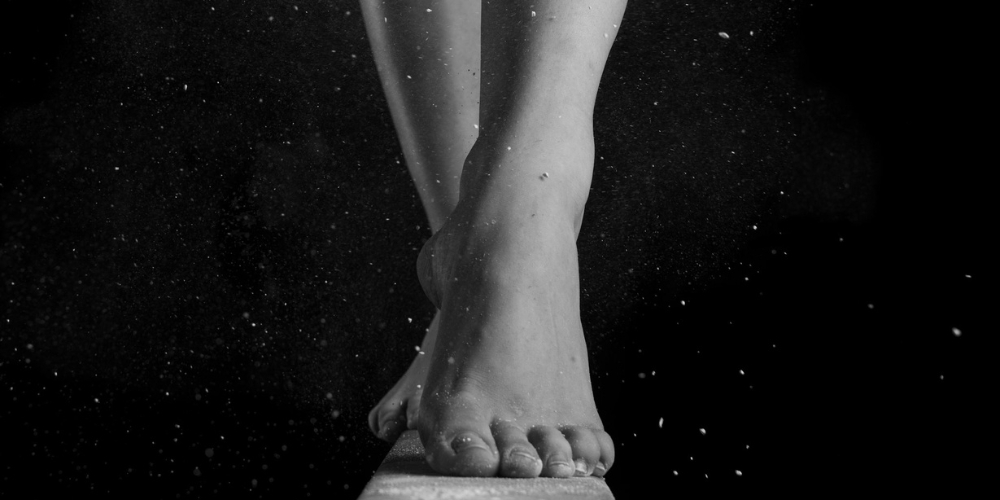
Now, you might think of chalk as a basic, white powder, but trust me, it's far from ordinary. Magnesium carbonate is like a magician in the world of gymnastics. It's hygroscopic, which means it's fantastic at absorbing moisture. This quality is a real lifesaver for gymnasts and acrobats because it keeps their hands dry and their grip rock-solid. Chalk is the ultimate defence against the dreaded slipping that can occur when palms or feet turn into mini-slips 'n slides during a high-intensity routine.
In our gym, you'll find chalk in block and powder forms housed in those trusty old chalk buckets. Gymnasts habitually "chalking up" right over the bucket to catch some of the dust that inevitably sprinkles the floor, wreaking havoc on vacuum cleaners worldwide. If you ever venture into the depths of gymnastics owners' forums and search for "which vacuum cleaner will last more than six months," you'll quickly discover that options are disappointingly limited.
But here's the exciting part: liquid chalk, a relatively new addition to the game, has been gaining popularity. It's a specialized product containing a suspension of magnesium carbonate in alcohol. The magnesium carbonate is the same stuff you find in traditional powdered gymnastics chalk. Still, the alcohol acts as a carrier, allowing it to be applied as a liquid and then quickly drying to create that familiar chalk-like layer on the hands. Liquid chalk is a game-changer, offering a mess-free and longer-lasting grip. Unlike traditional chalk, which can rub off during intense routines or training sessions, liquid chalk keeps athletes sweat-free for longer.
And here's a fun tidbit: blackboard chalk may share a name with gymnastics chalk, but they're entirely different creatures. Blackboard chalk is typically made of calcium sulfate, leaving visible marks on the board due to friction. You won't catch gymnasts using blackboard chalk in their routines. However, you might spot coaches using it to draw on the floor, and you'll certainly find club owners scrubbing it off into the wee hours of the morning.
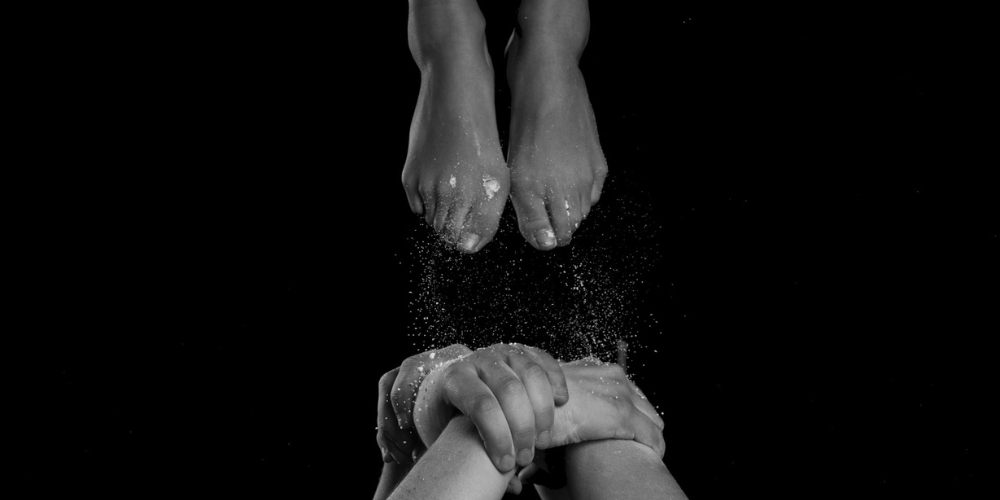
Gymnasts and acrobats are like artists with their chalk. They strategically apply it to their hands, feet, and any other points of contact with apparatus or fellow performers. The magnesium carbonate in chalk acts like a sponge, sopping up moisture and creating a dry, grippy surface. This seemingly unassuming white powder becomes a game-changer, allowing athletes to confidently execute manoeuvres precisely, regardless of how hot and sweaty things get in the performance arena.
Now, before each routine, gymnasts and acrobats have a little ritual known as "chalking up." It's a moment of focus and preparation where they meticulously apply chalk to their hands and other crucial points. The controlled application of chalk, whether it's in loose powder form, chalk blocks, or liquid chalk, is a highly personalized process. It lets athletes fine-tune their grip to meet the unique demands of their routine. As a coach, I've observed gymnasts using their "chalking up" time for all sorts of things—it's almost like the chalk bucket serves as the gym's water cooler. It's also an excellent spot to sneak in a breather from conditioning exercises, although I must say, athletes, we coaches do notice!
So, the next time you're awed by a flawless routine or a breathtaking acrobatic act, remember the invisible yet powerful presence of chalk—the secret ingredient that ensures a secure grip and makes the seemingly impossible, possible. It's not just a white powder; it's the gymnast's and acrobat's trusty ally in the pursuit of progress.
Gymnastics is often perceived as an art form that requires specialised equipment and professional coaching. However, in reality, gymnastics is a sport that can be adapted to various settings, including the comfort of your own home.
So, if you've ever glanced at a gymnastics routine and wondered, "Can I do that at home?" – the answer is a resounding yes.
"How to do gymnastics at home without equipment?" is a common topic among fitness lovers, and I'm here to tell you that it's possible and satisfying. As someone deeply involved in the gymnastics community, I've seen firsthand the transformational effect of this sport for all ages.
But before you kick off your shoes and clear your space in your living room, understand first my essential reminders and a roadmap for mastering gymnastics moves right in the comfort of your living room.
Before we get into the nitty-gritty of gymnastics moves you can do at home, let's talk about some crucial reminders. Safety first, right?
I can't stress this enough: warming up is non-negotiable. Before attempting any gymnastics exercises at home, make sure to warm up your body properly. Stretch your muscles, loosen your joints, and get the circulation circulating. It makes a huge difference.
To prepare your body for the demands of gymnastics, try activities like leg swings, arm circles, and light running. This not only lowers your risk of injury, but it also improves your performance during the actual manoeuvres. Remember that a well-executed warm-up sets the tone for an effective gymnastics routine.
Gymnastics is a sport that requires accuracy and spatial awareness. Consider this: you're in the middle of a beautiful handstand when you accidentally knock over a chair. Isn't that not ideal? Designate a clear and large location for gymnastics to avoid any unforeseen collisions with furniture or other household items.
A clutter-free zone reduces the possibility of accidents and allows you to expand and express yourself fully in each step. So, before you begin your gymnastics routine, run a quick scan of your chosen area to verify it is free of obstacles.
Being aware of your body's cues is crucial if you want to become a master gymnast. Pay attention to what your body tells you whenever an action seems overly strenuous or discomfort develops.
Begin with the fundamentals and work your way up at a speed that works for you. Overdoing it might result in setbacks and injuries, making your gymnastics adventure less enjoyable overall. Remember that it's an ongoing, fulfilling process rather than a race. Your body will eventually appreciate you for accepting the learning curve.
It's not necessary to have an entire closet full of gymnastics leotards. Still, appropriate clothing is essential for both performance and safety. Choose apparel that fits well and stretches to accommodate your entire range of motion. To prevent hindrance during dynamic movements, consider pulling back long hair, removing any jewellery, and tightening your shoelaces.
Proper clothing helps you feel more comfortable and confident overall and eliminates potential accidents in gymnastics, where accuracy is crucial. Thus, ensure you are properly prepared; your gymnastics routine will appreciate it.
Not only is it advised, but drinking plenty of water is the gasoline that propels your gymnastics adventure. It is crucial to approach your practise with the same level of commitment as you would at a professional gym, even when you are in the comfortable surroundings of your own home. You lose fluids as you exert yourself and move dynamically. Therefore, you need to replace them.
A reliable water bottle should always be close at hand during your workout. Drink water regularly to help your body heal, increase endurance, and keep your energy levels at their peak. Staying well hydrated is essential for maintaining optimal performance and making the most of every gymnastics session, not just for avoiding dehydration.
When practising gymnastics at home, if you're lucky enough to access a full-length mirror, consider it your hidden weapon for improving. Mirrors give instant feedback and let you see your form, posture, and technique. It's similar to having a personal coach who can provide invaluable insights.
When performing manoeuvres that need exact alignment, make use of the mirror. When performing a handstand, are your shoulders square? Do you perform a cartwheel with your body stretched correctly? Your self-correction ally is the mirror, which may assist you with modifications and ensure every move is performed skillfully. It's a straightforward but powerful tool that improves the calibre of your
Remember the significance of a decent cool-down when you finish your at-home gymnastics workout. Like warming up prepares your body for action, cooling down greatly impacts your general health. Target the muscle regions you used during your practise by including static stretches.
There are several uses for the cool-down period. First off, carefully extending muscles helps to increase flexibility. Thus, your range of motion is improved, and the chance of injury is decreased. Second, it's essential for reducing muscular discomfort and facilitating quicker recovery.
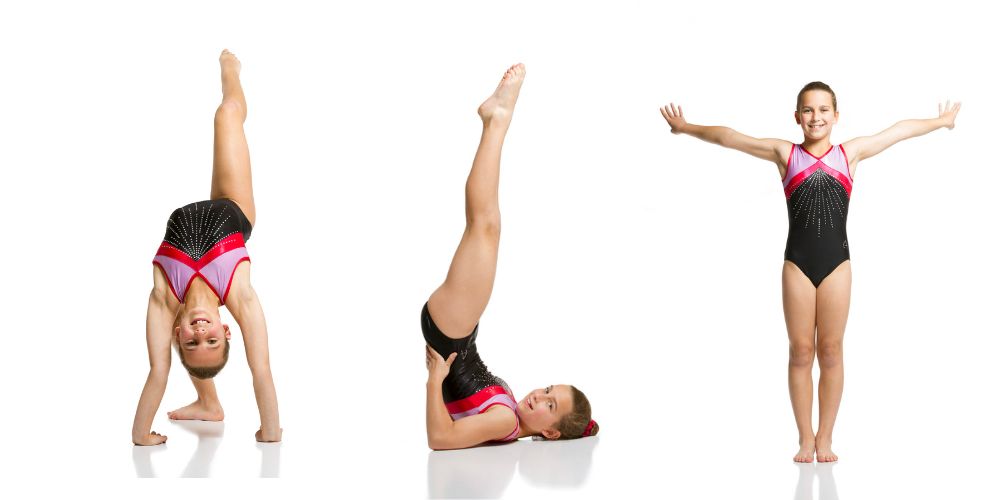
While it can be challenging to do gymnastics at home without equipment, you can still do many exercises.
Here's what you can do:
How to: Locate a clear area, firmly place your hands on the ground, kick your legs over, and presto! You've just executed a timeless manoeuvre. Finding your equilibrium may need a few tries, but that's all part of the learning curve. In addition to being visually stunning, cartwheels are an excellent way to increase upper body strength and coordination.
How-to: Using a strong wall as support, place your hands approximately a foot apart and kick your legs upward. This exercise is a game-changer for strengthening the shoulders and core and acclimating the body to the upside-down realm of handstands. For an added challenge, try extending one leg off the wall as you build confidence.
How to: Raise your hips towards the ceiling while lying on your back with your hands by your ears. The bridge position strengthens your back muscles and increases flexibility. Keep your core engaged throughout the exercise and concentrate on a controlled rise. It's a move that blends strength and grace beautifully.
How-to: The significance of grasping the fundamentals should be noticed. Roll forward, tuck your chin, and experience the rush of perfecting a basic gymnastics move. Not only are forward rolls great for novices, but they also help you become more aware of your body and enhance your coordination.
How-to: Gymnasts are known for their incredible flexibility; you can achieve it right at home. Incorporate lunges and splits into your routine to improve flexibility in your legs and hips. These stretches enhance your gymnastics performance and contribute to overall lower body strength.
How-to: Stand with your feet together and arms raised overhead. Jump off both feet while keeping your legs straight, forming a "V" shape in the air. Land with control and repeat. Pike jumps are a fantastic way to improve your explosive power, balance, and overall coordination.
How-to: Sit on the floor, legs stretched wide into a straddle position. With a straight back, lean forward and reach towards the ground. Hold the stretch for as long as it is comfortable. This move targets your core, inner thighs, and hamstrings, enhancing strength and flexibility.
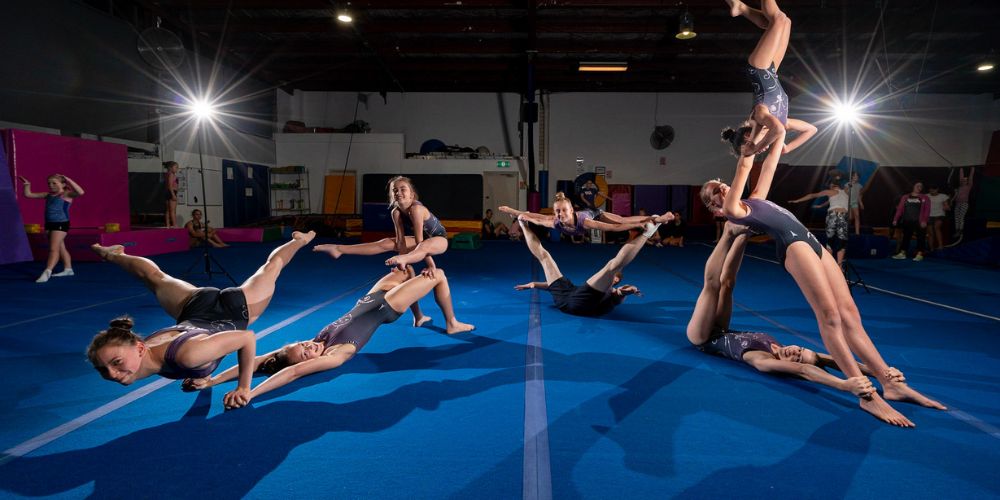
Now, you might be wondering – is it effective to learn gymnastics at home without the guidance of a professional coach?
Gymnastics at home allows you to practise on your own time and speed. This convenience is especially helpful for people who lead hectic lives or prefer to learn in a quiet environment.
There's no need for pricey gym subscriptions or specialised equipment while learning gymnastics at home. You don't have to break the money to start your gymnastics career with a small investment.
Practising at home makes learning more personalised. Without the interruptions or time limits frequently present in group lessons, you can concentrate on certain abilities or areas that need work.
A notable disadvantage is a qualified coach's need for instant, in-person coaching. Form correction, instantaneous feedback, and technique assurance are all crucial elements that can be difficult to handle without professional guidance.
Even while you can perform many fundamental gymnastics exercises at home without any equipment, the range and difficulty of the exercises can be restricted by the lack of specialty equipment like bars and beams. Furthermore, space restrictions can affect how some moves are performed.
Safety is one of the most important things in gymnastics. Inadequate form raises the possibility of injury without a trained coach's supervision. A regulated gym setting better fits some more difficult movements.
While learning gymnastics at home has advantages, it's crucial to strike a balance. Consider combining at-home practice with occasional visits to a gymnastics centre. Professional coaching, access to specialized equipment, and the camaraderie of fellow enthusiasts in a gym setting can complement your at-home efforts.
Certainly! Although it offers additional padding, a gymnastics mat is not required. You can practise the most fundamental techniques on a carpeted or grassy area. Just be careful and ensure no possible hazards in your practise area.
What happens if I can't perfect a move?
Gymnastics is a process rather than a final goal. If a certain move gives you trouble, dissect it into smaller parts. Practise each component separately before assembling them progressively. Challenges shouldn't deter you; they're a necessary component of learning.
How often should I train out at home for gymnastics?
Your fitness level and schedule determine the frequency you practise at home. Aim for three or four sessions a week, at the very least, concentrating on various gymnastics skills such as strength, flexibility, and skill-specific drills. The secret is consistency, so establish a schedule that suits you.
The importance of having access to top-notch equipment and skilled instruction cannot be overstated. However, you can advance in your gymnastics adventure at home provided you are committed, have a well-thought-out plan, and have the correct attitude.
Being consistent is crucial. Establish reasonable goals and a timeline, then follow it. You'll strike a balance that suits you if you mix in-home practise with sporadic trips to a gymnastics facility for more specialised instruction.
Remember, the key is to have fun, stay safe, and celebrate your progress, no matter how small.
Gymnastics floors are where amazing things happen—like strong moves, super flexibility, and beautiful expressions. One thing people might not think about is how big the floor is. But why does it matter?
Besides making sure our gymnasts stay on the right-sized floor, we focus on planning their routines. I've seen how the floor's size greatly affects how gymnasts perform.
When we create routines, we often think about the floor's size. It helps us decide how long tumbling tricks should be and where the dance parts fit. The floor's size is like a guide to ensuring everything looks smooth, and there's no risk of going too far out of bounds.
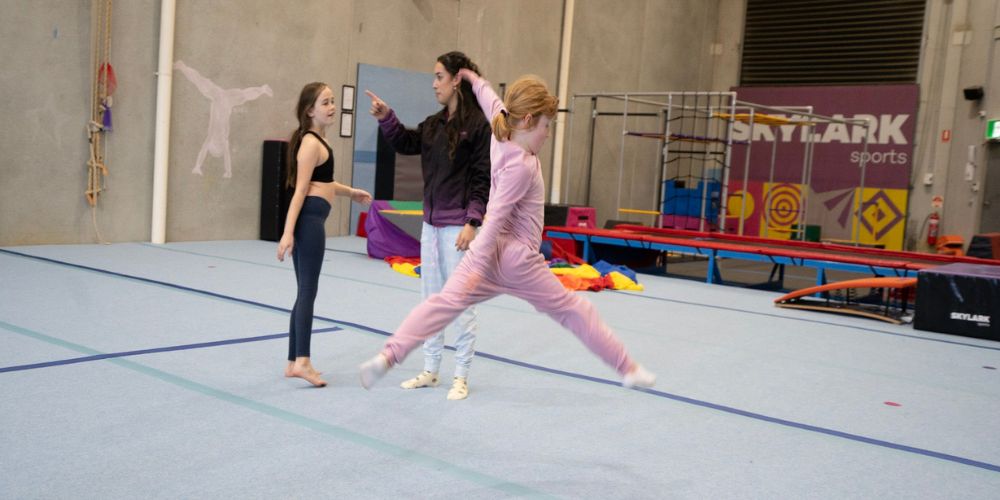
Before we start measuring dimensions, let's understand – why the size of the gymnastics floor matters.
Well, it's the stage where our gymnasts perform their gravity-defying feats. The right dimensions ensure a fair and challenging competition environment where precision is everything.
These amazing performances take place on the gymnastics floor. It's more than simply a surface; it's the place where aspirations soar, and gravity is defied. The right floor gives the routine the bounce and support it needs to become a show.
The measurements of the gymnastics floor in every gymnastics facility are more than just numbers; they are the builders of fairness and challenge. The floor's dimensions guarantee that gymnasts always have adequate room to perform their exciting routines without interference. On the other hand, the floor mat's thickness creates the ideal foundation for performance and safety by striking a careful balance between cushioning and responsiveness.
Imagine a gymnast practising hard, honing each technique on their floor. The floor feels different all of a sudden on competition day. That's what standardised dimensions are meant to avoid. Every gymnast in a competition has an equal chance to succeed if their measurements are consistent. There are no surprises—just fair play, with the only goal being to demonstrate talent and craftsmanship.
A magic combo of springs and foam layers underneath the floor, working together like a dream team. They give gymnasts the support and bounce they need. And that carpet on top? It's like the comfy shoes for gymnasts, ensuring they stick those landings and show off their best moves.
In the world of gymnastics, safety is paramount. The right gymnastics floor is not only about creating a breathtaking show but also about ensuring the well-being of the performers. The carefully selected materials and construction elements offer the necessary support to absorb impact, ensuring our gymnasts can soar without compromising safety.
According to Wikipedia:
The Fédération Internationale de Gymnastique (FIG) publishes apparatus measurements in the Apparatus Norms handbook. Both male and female competitors have the same measurements:
Artistic Gymnastics, Acrobatic Gymnastics
Rhythmic Gymnastics
When we talk about the length and width of a gymnastics floor, we're not talking about arbitrary measurements. Consider it the ideal size for our gymnasts to demonstrate their abilities. The length allows them to race, tumble, and awe us with their routines. The width is the sideline-to-sideline distance, which ensures they have the width to accomplish those gravity-defying acrobatics without colliding with the sidelines.
Now, let's talk about the comfy stuff – the thickness of the floor mat. It's like the secret sauce that adds the right bounce to the floor. It's too thin, and it's like performing on concrete. It's too thick, like jumping on a trampoline – fun but not practical. The ideal thickness strikes a balance, providing a comfy landing pad for our gymnasts without sacrificing the stability needed for those landings.
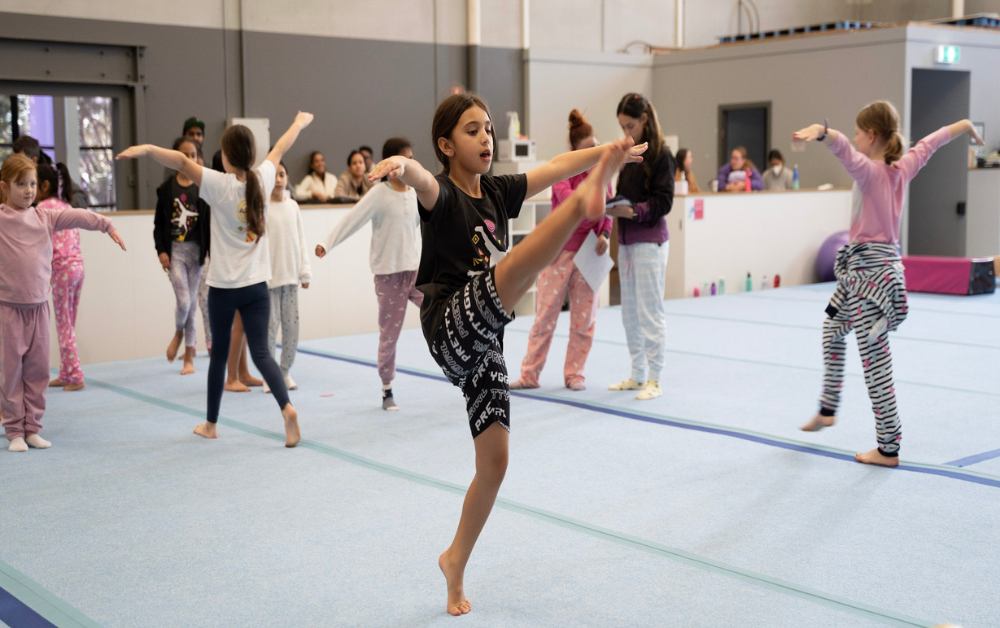
Now that we've covered the dimensions let's peek under the hood of the gymnastics floor and explore its key features.
Springs and foam layers
The foam layers and springs are like the dynamic pair that works behind the scenes to create an amazing performance. The ideal bounce is provided by the springs. The magic ingredient elevates an ordinary routine into a show that defies gravity. Then, there are the foam layers, which act as a supportive auxiliary. They lessen the pressure on our gymnasts' joints and guarantee a smooth landing by absorbing the shock. Together, these materials create a floor that's not just solid; it's a trampoline in disguise.
Carpet and covering
Let's now discuss the elegant floor covering and carpet. Think of the carpet as the gymnast's go-to pair of sneakers—it gives them the traction they require for those difficult routines. Like a magic carpet for the dance floor, it provides stability for spins and leaps. The floor's armour, however, is the covering. It shields the floor from deterioration and keeps it intact despite the continual assault of acrobatics. Together, that ensures our gymnasts perform on a stable and secure platform.
Now, let's talk about the real hurdles gymnasts face on the floor. It's not all glitz and glam; there are challenges that every gymnast encounters during their routines.
It takes skill to nail the landing. It's not just about sticking it, but sticking it with finesse. Gymnasts strive for perfection, and landing accurately is an ongoing challenge. Whether it's a somersault or a twist, the floor requires precision, and perfecting it takes time and practice.
Consider practising on one sort of floor and then moving to a different one for a competition - it's the same as changing dance partners mid-performance. Each floor has its personality, and gymnasts must adjust rapidly. The grip may change, the bounce may feel different, and changing on the fly is an art in and of itself.
The gymnast's safe zone is the floor mat, and navigating its perimeter might be difficult. With one incorrect step, they could find themselves out of bounds. It's a tightrope act that requires skill and spatial awareness to stay within the authorised performance space.
Gymnastic routines are scripted dances that include flips and twists. Maintaining a steady flow of tumbling sequences without failing is difficult. Executing each move precisely and transitioning from one to the next is important, producing a flowing and visually pleasing routine.
The floor is not just physical; it's a mental battleground. Gymnasts often face immense pressure during competitions. The eyes of judges, the expectations of coaches, and the desire to outdo their best performances are psychological challenges that add complexity to every routine.
These challenges might seem daunting for our gymnasts, but they make gymnastics an incredible sport. Overcoming these hurdles requires skill, determination, and mental resilience. It's not just about sticking a landing; it's about conquering a series of challenges, turning each routine into a triumph of skill and perseverance.
No, the size of the gymnastics floor remains the same between contests. Still, the materials and construction may differ from one facility to the next. Some facilities may employ springs or foam layers, resulting in a slightly distinct feel. However, adhering to competition rules helps gymnasts develop their talents in varied contexts and have a consistent experience.
The gymnastics floor's springiness is a precisely crafted element designed to improve performance. Springs are deliberately positioned beneath the surface to provide a powerful launchpad for gymnasts. These springs provide the lift required for flips, twists, and dynamic movements. Gymnasts may execute their routines with precision and flair because of the regulated bounce. The springiness is a testament to the marriage of athleticism and engineering, resulting in an atmosphere that allows gymnasts to push their limits while remaining in control.
Gymnasts do not usually get to choose the floor covering. Choosing floor coverings is a careful process driven by competition standards. The covering, typically carpet-like, is chosen for its distinctive texture and grip to guarantee that all gymnasts have a fair and consistent experience. Consider how the level playing field would be disrupted if basketball players had to adapt to various court materials in every game. Similarly, standardised floor coverings help to ensure fair competition by allowing gymnasts to concentrate on their routines rather than adjusting to different surfaces.
As we finished our look into the gymnastics floor, it was clear this space was super important in gymnastics. The size rules make it fair for everyone at Skylarks Sports or other gyms worldwide.
Under the floor, springs and foam help gymnasts jump high and do cool moves. The floor isn't the same everywhere, but gymnasts are like superheroes, adapting to different floors with different grips.
So, remember, the gymnastics floor isn't just about its size. It's a stage for gymnasts to show what they can do.